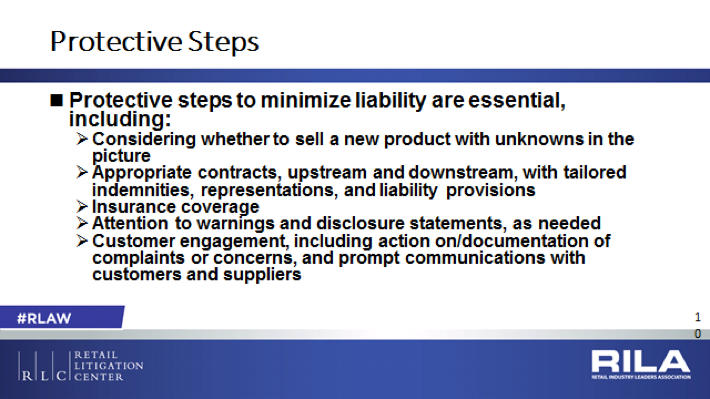Lynn L. Bergeson Presents “Innovative Consumer Products and Legal Risk” at the 2017 Retail Law Conference in Chicago, Illinois
On October 12, 2017, Lynn L. Bergeson, Managing Partner, Bergeson & Campbell, P.C. (B&C®), presented at the “Innovative Consumer Products and Legal Risk” breakout session at the 2017 Retail Law Conference in Chicago, Illinois. The Retail Industry Leaders Association’s (RILA) Retail Litigation Center hosts this annual gathering of in-house counsel to cover pressing issues facing the retail industry and provide opportunity for interactive participation in roundtable discussions, Questions and Answers (Q&A) with speakers, and networking breaks. There is a strong industry presence, with attendance by corporate counsel from over 75 leading brands, including Rite Aid, Microsoft, McDonalds, and Walmart. B&C was a proud sponsor of this informative networking event.
Tricia Foley, General Counsel, Micro-Pak Ltd., and James J. Jones, Executive Vice President of the Consumer Specialty Products Association, participated in the “Innovative Consumer Products and Legal Risk” session. Evolving technologies are generally embraced by retailers as sure-fire pathways to marketing success. But when selling products with new modes of action and spiffy new product attributes, retailers may be part of a product liability chain. This presentation gave the audience a peek behind the technology curtain to explore the legal and regulatory underpinnings of a variety of new consumer products, such as those imbued with nanotechnology ingredients.
Bergeson kicked off the presentation with a primer on the intersection of innovation and product liability, as new products can have incomplete data on product risks and their potential impacts, and can disrupt regulatory systems built to manage more traditional products. Bergeson also discussed changes to tort law in the past 50 years that have enabled plaintiffs seeking damages for alleged harm from products to go beyond the limits of negligence or warranty theories. This “Strict Liability” opens the door to liability without fault where a “defective” product is involved, and it lowers the bar for who in the distribution chain may become a defendant.

The breakout session panelists then discussed three relevant case studies: “Marketing Deregulated ‘Natural’ Pesticide Products”; “Undisclosed, Unregistered Pesticide Products”; and “Synthetic Squalene – And Answering Questions.” Jones, as immediate past Assistant Administrator of the U.S. Environmental Protection Agency’s (EPA) Toxics program office, presented the case study on “natural” pesticides and the commercial mischief and potential liability such products present to retailers. Foley presented the “Undisclosed, Unregistered Pesticide Products” case study, regarding unknown anti-mold pesticides that are used in shoe boxes. The product is thought to be allyl isothiocyanate (AITC), which is not registered for this use under the Federal Insecticide, Fungicide, and Rodenticide Act (FIFRA), which can expose U.S. distributors and retailers of the imported products to liability if consumers are harmed by exposure to the unregistered pesticidal ingredients.

A detailed paper, “Innovation, Consumer Products, and Legal Risk: Points to Consider” written by Bergeson and Bethami Auerbach, was made available to compliment the presentation. The paper provides an overview of emerging legal and practical issues pertinent to the inclusion of technologies supporting products marketed to the public, as well as a review of the case studies featured in “Innovative Consumer Products and Legal Risk.” This detailed review of liability law, with an eye to the current market, makes it clear how regulatory initiatives and governance mechanisms become all the more important. As EPA, other federal and state regulatory bodies, and stakeholders alike have the benefit of better information about the health and environmental impacts of advanced materials of all types, the regulatory pathway forward will be more informed and, from a stakeholder’s perspective, less obscure. While a more developed regulatory framework is still years away, businesses also need to be mindful of potential citizen action suits under federal and state laws seeking the imposition of liability for cleanup of hazardous substances and/or natural resource damages. Even if such actions are unsuccessful, their nuisance value and potential for inviting unwanted media attention should not be underestimated.
For more information, a full copy of the presentation, and “Innovation, Consumer Products, and Legal Risk: Points to Consider,” contact Heidi Lewis at hlewis@lawbc.com.
